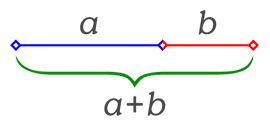The Golden Ratio: Beginning the Geometry of

Here is the previous post concerning the Golden Ratio. For a collection of all the posts concerning the Golden Ratio, click #GoldenRatio below.
Now that we know what the golden ratio is, and why people like it, let's look at it in a geometrical sense, as the greeks would have. One definition of the golden ratio is the one that started this series, based on the golden rectangle. Another definition is as follows:
Divide a line segment into two parts. The Golden Ratio is the ratio of the larger part to the whole, when that ratio is also equal to the ratio of the smaller part to the larger part.
Basically, imagine the line segment pictured above. When we set the two proportions equal to each other we get
Solving this like we did in the first post will indeed yield .
Since this post is kind of short too, I'll add in a teaser. If someone can effectively answer my question before this evening (in the next ten hours), I'll put up the tomorrow's post tonight.
Here's the question: What are the lengths of the diagonals of a regular unit pentagon? Prove it.
See the full proof in here
Easy Math Editor
This discussion board is a place to discuss our Daily Challenges and the math and science related to those challenges. Explanations are more than just a solution — they should explain the steps and thinking strategies that you used to obtain the solution. Comments should further the discussion of math and science.
When posting on Brilliant:
*italics*or_italics_**bold**or__bold__paragraph 1
paragraph 2
[example link](https://brilliant.org)> This is a quote# I indented these lines # 4 spaces, and now they show # up as a code block. print "hello world"\(...\)or\[...\]to ensure proper formatting.2 \times 32^{34}a_{i-1}\frac{2}{3}\sqrt{2}\sum_{i=1}^3\sin \theta\boxed{123}Comments
Click here for the image
ABCDE is a regular pentagon with side length 1
AD,AC & EB is the diagonals of the pentagon
AD intersect EB at point F,AC intersect EB at point G
AF=EF=y, so △AEF is a isosceles triangle
△DEF is a isoceles triangle, so ED=FD=1
So,the diagonals=1+y
∠FAE=∠AEF=∠EDF=36∘
∠AED=∠AFE=108∘
△AFE∼△ADE So that, 11+y=y1
aa+b=ba=ϕ
By substituting a=1,b=y
We get, 11+y=y1=ϕ
The length of the diagonals is ϕ≈1.618
Log in to reply
Is there another way?
Log in to reply
An alternate way is to apply cosine rule in one of the triangles.
If a is the length of the diagonal, use cosine rule to get a2=2.618approximately equal to 1+ϕ and from here recall that 1+ϕ=ϕ2it is easy to get a=ϕ.
Log in to reply
Right. This is the way I first discovered it.
this is the way I think
I will attach an image after I know how to attach an image
I attach the image already
it is very interesting to know that the equivalent resistance of thiscircuit where all the resistances are 1 ohm is GOLDEN RATIO. I think this is because of the existence of the ratio in the radical form
Log in to reply
Very interesting indeed.